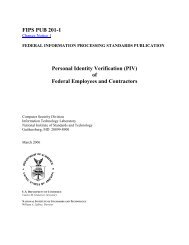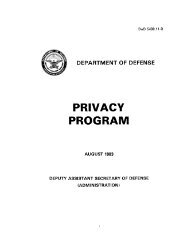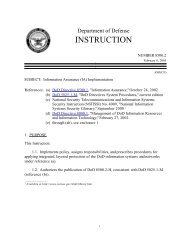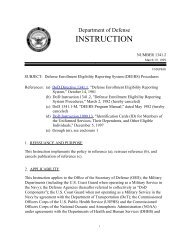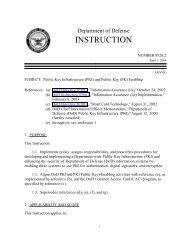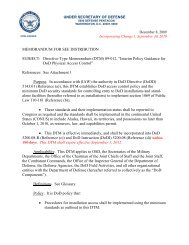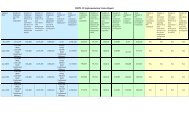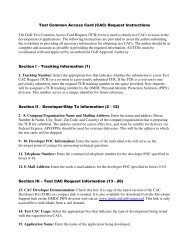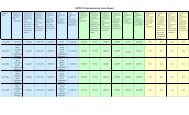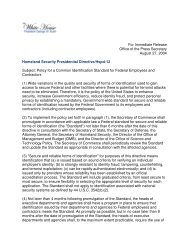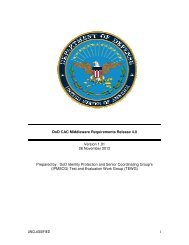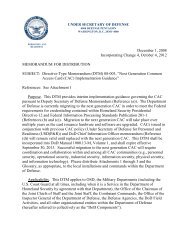DoD Directive 8500.1 - Common Access Card (CAC)
DoD Directive 8500.1 - Common Access Card (CAC)
DoD Directive 8500.1 - Common Access Card (CAC)
Create successful ePaper yourself
Turn your PDF publications into a flip-book with our unique Google optimized e-Paper software.
Department of Defense<br />
DIRECTIVE<br />
NUMBER <strong>8500.1</strong><br />
October 24, 2002<br />
ASD(C3I)<br />
SUBJECT: Information Assurance (IA)<br />
(a) Section 2224 of title 10, United States Code, "Defense Information<br />
Assurance Program"<br />
(b) <strong>DoD</strong> <strong>Directive</strong> 5200.28, "Security Requirements for Automated<br />
Information Systems (AISs)," March 21, 1988 (hereby canceled)<br />
(c) <strong>DoD</strong> 5200.28-M, "ADP Security Manual," January 1973 (hereby<br />
canceled)<br />
(d) <strong>DoD</strong> 5200.28-STD, "<strong>DoD</strong> Trusted Computer Security Evaluation<br />
Criteria," December 1985 (hereby canceled)<br />
(e) through (ai), see enclosure 1<br />
1. PURPOSE<br />
This <strong>Directive</strong>:<br />
1.1. Establishes policy and assigns responsibilities under reference (a) to achieve<br />
Department of Defense (<strong>DoD</strong>) information assurance (IA) through a defense-in-depth<br />
approach that integrates the capabilities of personnel, operations, and technology, and<br />
supports the evolution to network centric warfare.<br />
1.2. Supersedes <strong>DoD</strong> <strong>Directive</strong> 5200.28, <strong>DoD</strong> 5200.28-M, <strong>DoD</strong> 5200.28-STD, and<br />
<strong>DoD</strong> Chief Information Officer (CIO) Memorandum 6-8510 (references (b), (c), (d)<br />
and (e)).<br />
1.3. Designates the Secretary of the Army as the Executive Agent for the<br />
integration of common biometric technologies throughout the Department of Defense.<br />
1.4. Authorizes the publication of <strong>DoD</strong> 8500.aa-M consistent with <strong>DoD</strong> 5025.1-M<br />
(reference (f)).<br />
1
DODD <strong>8500.1</strong>, October 24, 2002<br />
2. APPLICABILITY AND SCOPE<br />
2.1. This <strong>Directive</strong> applies to:<br />
2.1.1. The Office of the Secretary of Defense, the Military Departments, the<br />
Chairman of the Joint Chiefs of Staff, the Combatant Commands, the Inspector General<br />
of the Department of Defense, the Defense Agencies, the <strong>DoD</strong> Field Activities, and all<br />
other organizational entities within the Department of Defense (hereafter referred to<br />
collectively as "the <strong>DoD</strong> Components").<br />
2.1.2. All <strong>DoD</strong>-owned or -controlled information systems that receive,<br />
process, store, display or transmit <strong>DoD</strong> information, regardless of mission assurance<br />
category, classification or sensitivity, including but not limited to:<br />
2.1.2.1. <strong>DoD</strong> information systems that support special environments, e.g.,<br />
Special <strong>Access</strong> Programs (SAP) and Special <strong>Access</strong> Requirements (SAR), as<br />
supplemented by the special needs of the program.<br />
2.1.2.2. Platform IT interconnections, e.g., weapons systems, sensors,<br />
medical technologies or utility distribution systems, to external networks.<br />
Defense.<br />
2.1.2.3. Information systems under contract to the Department of<br />
2.1.2.4. Outsourced information-based processes such as those<br />
supporting e-Business or e-Commerce processes.<br />
2.1.2.5. Information systems of Nonappropriated Fund Instrumentalities.<br />
2.1.2.6. Stand-alone information systems.<br />
2.1.2.7. Mobile computing devices such as laptops, handhelds, and<br />
personal digital assistants operating in either wired or wireless mode, and other<br />
information technologies as may be developed.<br />
2.2. Nothing in this policy shall alter or supercede the existing authorities and<br />
policies of the Director of Central Intelligence (DCI) regarding the protection of<br />
Sensitive Compartmented Information (SCI) and special access programs for<br />
intelligence as directed by Executive Order 12333 (reference (g)) and other laws and<br />
regulations.<br />
2
DODD <strong>8500.1</strong>, October 24, 2002<br />
2.3. This policy does not apply to weapons systems as defined by <strong>DoD</strong> <strong>Directive</strong><br />
5137.1 (reference (h)) or other IT components, both hardware and software, that are<br />
physically part of, dedicated to, or essential in real time to a platform's mission<br />
performance where there is no platform IT interconnection.<br />
3. DEFINITIONS<br />
Terms used in this <strong>Directive</strong> are defined in National Security Telecommunications and<br />
Information Systems Security Instruction Number 4009 (reference (i)) or enclosure 2.<br />
4. POLICY<br />
It is <strong>DoD</strong> policy that:<br />
4.1. Information assurance requirements shall be identified and included in the<br />
design, acquisition, installation, operation, upgrade, or replacement of all <strong>DoD</strong><br />
information systems in accordance with 10 U.S.C. Section 2224, Office of Management<br />
and Budget Circular A-130, Appendix III, <strong>DoD</strong> <strong>Directive</strong> 5000.1 (references (a), (j) and<br />
(k)), this <strong>Directive</strong>, and other IA-related <strong>DoD</strong> guidance, as issued.<br />
4.2. All <strong>DoD</strong> information systems shall maintain an appropriate level of<br />
confidentiality, integrity, authentication, non-repudiation, and availability that reflect a<br />
balance among the importance and sensitivity of the information and information assets;<br />
documented threats and vulnerabilities; the trustworthiness of users and interconnecting<br />
systems; the impact of impairment or destruction to the <strong>DoD</strong> information system; and<br />
cost effectiveness. For IA purposes all <strong>DoD</strong> information systems shall be organized<br />
and managed in the four categories defined in enclosure 2: automated information<br />
system (AIS) applications, enclaves (which include networks), outsourced IT-based<br />
processes, and platform IT interconnections.<br />
4.3. Information assurance shall be a visible element of all investment portfolios<br />
incorporating <strong>DoD</strong>-owned or -controlled information systems, to include outsourced<br />
business processes supported by private sector information systems and outsourced<br />
information technologies; and shall be reviewed and managed relative to contributions to<br />
mission outcomes and strategic goals and objectives, in accordance with 40 U.S.C.<br />
Sections 1423 and 1451 (reference (l)). Data shall be collected to support reporting<br />
and IA management activities across the investment life cycle.<br />
3
DODD <strong>8500.1</strong>, October 24, 2002<br />
4.4. Interoperability and integration of IA solutions within or supporting the<br />
Department of Defense shall be achieved through adherence to an architecture that will<br />
enable the evolution to network centric warfare by remaining consistent with the<br />
Command, Control, Communications, Computers, Intelligence, Surveillance,<br />
Reconnaissance Architecture Framework, and a defense-in-depth approach. This<br />
combination produces layers of technical and non-technical solutions that: provide<br />
appropriate levels of confidentiality, integrity, authentication, non-repudiation, and<br />
availability; defend the perimeters of enclaves; provide appropriate degrees of<br />
protection to all enclaves and computing environments; and make appropriate use of<br />
supporting IA infrastructures, to include robust key management and incident detection<br />
and response.<br />
4.5. The Department of Defense shall organize, plan, assess, train for, and conduct<br />
the defense of <strong>DoD</strong> computer networks as integrated computer network defense (CND)<br />
operations that are coordinated across multiple disciplines in accordance with <strong>DoD</strong><br />
<strong>Directive</strong> O-8530.1 (reference (m)).<br />
4.6. Information assurance readiness shall be monitored, reported and evaluated as<br />
a distinguishable element of mission readiness throughout all the <strong>DoD</strong> Components, and<br />
validated by the <strong>DoD</strong> CIO.<br />
4.7. All <strong>DoD</strong> information systems shall be assigned a mission assurance category<br />
that is directly associated with the importance of the information they contain relative<br />
to the achievement of <strong>DoD</strong> goals and objectives, particularly the warfighters' combat<br />
mission. Requirements for availability and integrity are associated with the mission<br />
assurance category, while requirements for confidentiality are associated with the<br />
information classification or sensitivity and need-to-know. Both sets of requirements<br />
are primarily expressed in the form of IA controls and shall be satisfied by employing<br />
the tenets of defense-in-depth for layering IA solutions within a given IT asset and among<br />
assets; and ensuring appropriate robustness of the solution, as determined by the relative<br />
strength of the mechanism and the confidence that it is implemented and will perform as<br />
intended. The IA solutions that provide availability, integrity, and confidentiality also<br />
provide authentication and non-repudiation.<br />
4.8. <strong>Access</strong> to all <strong>DoD</strong> information systems shall be based on a demonstrated<br />
need-to-know, and granted in accordance with applicable laws and <strong>DoD</strong> 5200.2-R<br />
(reference (n)) for background investigations, special access and IT position<br />
designations and requirements. An appropriate security clearance and non-disclosure<br />
agreement are also required for access to classified information in accordance with<br />
<strong>DoD</strong> 5200.1-R (reference (o)). Further:<br />
4
DODD <strong>8500.1</strong>, October 24, 2002<br />
4.8.1. The minimum requirement for <strong>DoD</strong> information system access shall be<br />
a properly administered and protected individual identifier and password.<br />
4.8.2. The use of Public Key Infrastructure (PKI) certificates and biometrics<br />
for positive authentication shall be in accordance with published <strong>DoD</strong> policy and<br />
procedures. These technologies shall be incorporated in all new acquisitions and<br />
upgrades whenever possible. Where interoperable PKI is required for the exchange of<br />
unclassified information with vendors and contractors, the Department of Defense shall<br />
only accept PKI certificates obtained from a <strong>DoD</strong>-approved external certificate<br />
authority or other mechanisms approved in accordance with <strong>DoD</strong> policy.<br />
4.9. In addition to the requirements in paragraph 4.8., foreign exchange personnel<br />
and representatives of foreign nations, coalitions or international organizations may be<br />
authorized access to <strong>DoD</strong> information systems containing classified or sensitive<br />
information only if all of the following conditions are met:<br />
4.9.1. <strong>Access</strong> is authorized only by the <strong>DoD</strong> Component Head in accordance<br />
with the Department of Defense, the Department of State (DoS), and DCI disclosure and<br />
interconnection policies, as applicable.<br />
4.9.2. Mechanisms are in place to strictly limit access to information that has<br />
been cleared for release to the represented foreign nation, coalition or international<br />
organization, (e.g., North Atlantic Treaty Organization) in accordance with <strong>DoD</strong><br />
<strong>Directive</strong>s 5230.11 (reference (p)), for classified information, and other policy<br />
guidance for unclassified information such as reference (o), <strong>DoD</strong> <strong>Directive</strong> 5230.20<br />
(reference (q)), and <strong>DoD</strong> Instruction 5230.27 (reference (r)).<br />
4.10. Authorized users who are contractors, <strong>DoD</strong> direct or indirect hire foreign<br />
national employees, or foreign representatives as described in paragraph 4.9., above,<br />
shall always have their affiliation displayed as part of their e-mail addresses.<br />
4.11. <strong>Access</strong> to <strong>DoD</strong>-owned, -operated or -outsourced web sites shall be strictly<br />
controlled by the web site owner using technical, operational and procedural measures<br />
appropriate to the web site audience and information classification or sensitivity.<br />
4.11.1. <strong>Access</strong> to <strong>DoD</strong>-owned, -operated or -controlled web sites containing<br />
official information shall be granted according to reference (o) and need-to-know rules<br />
established by the information owner.<br />
4.11.2. <strong>Access</strong> to <strong>DoD</strong>-owned, -operated or -controlled web sites containing<br />
public information is not restricted; however, the information accessible through the<br />
5
DODD <strong>8500.1</strong>, October 24, 2002<br />
web sites shall be limited to unclassified information that has been reviewed and<br />
approved for release in accordance with <strong>DoD</strong> <strong>Directive</strong> 5230.9 and <strong>DoD</strong> Instruction<br />
5230.29 (references (s) and (t)).<br />
4.12. <strong>DoD</strong> information systems shall regulate remote access and access to the<br />
Internet by employing positive technical controls such as proxy services and screened<br />
subnets, also called demilitarized zones (DMZ), or through systems that are isolated<br />
from all other <strong>DoD</strong> information systems through physical means. This includes remote<br />
access for telework.<br />
4.13. All <strong>DoD</strong> information systems shall be certified and accredited in accordance<br />
with <strong>DoD</strong> Instruction 5200.40 (reference (u)).<br />
4.14. All interconnections of <strong>DoD</strong> information systems shall be managed to<br />
continuously minimize community risk by ensuring that the assurance of one system is<br />
not undermined by vulnerabilities of interconnected systems.<br />
4.14.1. Interconnections of Intelligence Community (IC) systems and <strong>DoD</strong><br />
information systems shall be accomplished using a process jointly established by the<br />
<strong>DoD</strong> CIO and the IC CIO.<br />
4.14.2. Connection to the Defense Information System Network (DISN) shall<br />
comply with connection approval procedures and processes, as established.<br />
4.14.3. Interconnections among <strong>DoD</strong> information systems of different<br />
security domains or with other U.S. Government systems of different security domains<br />
shall be employed only to meet compelling operational requirements, not operational<br />
convenience. Secure configurations of approved IA and IA-enabled IT products, uniform<br />
risk criteria, trained systems security personnel, and strict configuration control shall be<br />
employed. The community risk shall be assessed and measures taken to mitigate that<br />
risk in accordance with procedures established by the DISN Designated Approving<br />
Authorities (DAAs) prior to interconnecting the systems.<br />
6
DODD <strong>8500.1</strong>, October 24, 2002<br />
4.14.4. The interconnection of <strong>DoD</strong> information systems with those of U.S.<br />
allies, foreign nations, coalition partners, or international organizations shall comply<br />
with applicable international agreements and, whenever possible, <strong>DoD</strong> IA policies.<br />
Variations shall be approved by the responsible Combatant Commander and the DISN<br />
DAAs, and incorporated in the system security documentation. Information provided<br />
through these interconnections must be released in accordance with (reference (o)) or<br />
(reference (p)).<br />
4.15. All <strong>DoD</strong> information systems shall comply with <strong>DoD</strong> ports and protocols<br />
guidance and management processes, as established.<br />
4.16. The conduct of all <strong>DoD</strong> communications security activities, including the<br />
acquisition of COMSEC products, shall be in accordance with <strong>DoD</strong> <strong>Directive</strong> C-5200.5<br />
(reference (v)).<br />
4.17. All IA or IA-enabled IT hardware, firmware, and software components or<br />
products incorporated into <strong>DoD</strong> information systems must comply with the evaluation<br />
and validation requirements of National Security Telecommunications and Information<br />
Systems Security Policy Number 11 (reference (w)). Such products must be<br />
satisfactorily evaluated and validated either prior to purchase or as a condition of<br />
purchase; i.e., vendors will warrant, in their responses to a solicitation and as a condition<br />
of the contract, that the vendor's products will be satisfactorily validated within a period<br />
of time specified in the solicitation and the contract. Purchase contracts shall specify<br />
that product validation will be maintained for updated versions or modifications by<br />
subsequent evaluation or through participation in the National IA Partnership (NIAP)<br />
Assurance Maintenance Program.<br />
4.18. All IA and IA-enabled IT products incorporated into <strong>DoD</strong> information systems<br />
shall be configured in accordance with <strong>DoD</strong>-approved security configuration guidelines. 1<br />
4.19. Public domain software products, and other software products with limited or<br />
no warranty, such as those commonly known as freeware or shareware, shall only be<br />
used in <strong>DoD</strong> information systems to meet compelling operational requirements. Such<br />
products shall be thoroughly assessed for risk and accepted for use by the responsible<br />
DAA.<br />
_____________<br />
1<br />
Guidelines are available at http://iase.disa.mil/ and http://www.nsa.gov/<br />
7
DODD <strong>8500.1</strong>, October 24, 2002<br />
4.20. <strong>DoD</strong> information systems shall be monitored based on the assigned mission<br />
assurance category and assessed risk in order to detect, isolate, and react to intrusions,<br />
disruption of services, or other incidents that threaten the IA of <strong>DoD</strong> operations or IT<br />
resources, including internal misuse. <strong>DoD</strong> information systems also shall be subject to<br />
active penetrations and other forms of testing used to complement monitoring activities<br />
in accordance with <strong>DoD</strong> and Component policy and restrictions.<br />
4.21. Identified <strong>DoD</strong> information system vulnerabilities shall be evaluated for <strong>DoD</strong><br />
impact, and tracked and mitigated in accordance with <strong>DoD</strong>-directed solutions, e.g.,<br />
Information Assurance Vulnerability Alerts (IAVAs).<br />
4.22. All personnel authorized access to <strong>DoD</strong> information systems shall be<br />
adequately trained in accordance with <strong>DoD</strong> and Component policies and requirements<br />
and certified as required in order to perform the tasks associated with their IA<br />
responsibilities.<br />
4.23. Individuals shall be notified of their privacy rights and security<br />
responsibilities in accordance with <strong>DoD</strong> Component General Counsel-approved<br />
processes when attempting access to <strong>DoD</strong> information systems.<br />
4.24. Mobile code technologies shall be categorized and controlled to reduce their<br />
threat to <strong>DoD</strong> information systems in accordance with <strong>DoD</strong> and Component policy and<br />
guidance.<br />
4.25. A DAA shall be appointed for each <strong>DoD</strong> information system operating within<br />
or on behalf of the Department of Defense, to include outsourced business processes<br />
supported by private sector information systems and outsourced information<br />
technologies. The DAA shall be a U.S. citizen, a <strong>DoD</strong> employee, and have a level of<br />
authority commensurate with accepting, in writing, the risk of operating <strong>DoD</strong><br />
information systems under his or her purview.<br />
4.26. All military voice radio systems, to include cellular and commercial<br />
services, shall be protected consistent with the classification or sensitivity of the<br />
information transmitted on the system.<br />
5. RESPONSIBILITIES<br />
5.1. The Assistant Secretary of Defense for Command, Control, Communications,<br />
and Intelligence (ASD(C3I)), as the <strong>DoD</strong> Chief Information Officer (<strong>DoD</strong> CIO) shall:<br />
8
DODD <strong>8500.1</strong>, October 24, 2002<br />
5.1.1. Monitor, evaluate and provide advice to the Secretary of Defense<br />
regarding all <strong>DoD</strong> IA activities.<br />
5.1.2. Oversee appropriations earmarked for the <strong>DoD</strong> IA program and manage<br />
the supporting activities of the office of the Defense-wide Information Assurance<br />
Program (DIAP) Office in accordance with reference (a).<br />
5.1.3. Develop and promulgate additional IA policy guidance consistent with<br />
this <strong>Directive</strong> to address such topics as ports and protocols management, vulnerability<br />
management, biometrics, security management, IA education and training, mobile code,<br />
and interconnection between security domains.<br />
5.1.4. Ensure the integration of IA initiatives with critical infrastructure<br />
protection sector liaisons, as defined in <strong>DoD</strong> <strong>Directive</strong> 5160.54 (reference (x)).<br />
5.1.5. Establish a formal coordination process with the IC CIO to ensure<br />
proper protection of IC information within the Department of Defense.<br />
5.1.6. Establish metrics and annually validate the IA readiness of all <strong>DoD</strong><br />
Components as an element of mission readiness.<br />
5.1.7. Ensure that responsibilities for IA aspects of Major Defense<br />
Acquisition Program design are integrated into existing Under Secretary of Defense<br />
(Acquisition, Technology and Logistics) (USD(AT&L)) and Service Acquisition<br />
Executive processes.<br />
5.1.8. Require the Director, Defense Information Systems Agency to:<br />
5.1.8.1. Develop, implement and oversee a single IA approach for layered<br />
protection (defense-in-depth) of the DISN in coordination with the Chairman of the<br />
Joint Chiefs of Staff, Director, Defense Intelligence Agency (DIA) and Director,<br />
National Security Agency (NSA).<br />
DISN.<br />
5.1.8.2. Establish and manage connection approval processes for the<br />
5.1.8.3. Develop and provide IA training and awareness products.<br />
5.1.8.4. Develop and provide security configuration guidance for IA and<br />
IA-enabled IT products in coordination with Director, NSA.<br />
9
DODD <strong>8500.1</strong>, October 24, 2002<br />
5.1.8.5. Establish and implement:<br />
5.1.8.5.1. A <strong>DoD</strong> ports and protocols management process.<br />
5.1.8.5.2. Procedures for mitigation of risks associated with the use<br />
of mobile code in <strong>DoD</strong> information systems.<br />
5.1.8.5.3. A web-based resource providing access to current <strong>DoD</strong> and<br />
Federal IA and IA-related policy and guidance, including recent and pending legislation.<br />
5.1.9. Require the Director, Defense Intelligence Agency to:<br />
5.1.9.1. Provide finished intelligence on IA, including threat assessments,<br />
to the <strong>DoD</strong> Components.<br />
5.1.9.2. Develop, implement, and oversee an IA program for layered<br />
protection of the <strong>DoD</strong> non-cryptologic SCI systems including the <strong>DoD</strong> Intelligence<br />
Information System (<strong>DoD</strong>IIS) on the basis of defined <strong>DoD</strong> information systems and<br />
geographical or organizational boundaries.<br />
5.1.9.3. Certify and accredit <strong>DoD</strong> non-cryptologic SCI and <strong>DoD</strong>IIS<br />
applications, enclaves, platform IT interconnections, and outsourced IT-based processes,<br />
and develop and provide an IA education, training, and awareness program for <strong>DoD</strong><br />
non-cryptologic SCI systems and <strong>DoD</strong>IIS users and administrators.<br />
5.1.9.4. Establish and manage a connection-approval process for the Joint<br />
Worldwide Intelligence Communications System (JWICS).<br />
5.1.10. Require the Director, Defense Security Service to monitor<br />
information system security practices and conduct regular inspections of <strong>DoD</strong><br />
contractors processing classified information in accordance with <strong>DoD</strong> 5220.22-M<br />
(reference (y)).<br />
5.2. The Under Secretary of Defense for Acquisition, Technology and Logistics<br />
(USD(AT&L)) shall:<br />
5.2.1. Require the Director, Defense Research and Engineering (DDR&E) to:<br />
10
DODD <strong>8500.1</strong>, October 24, 2002<br />
5.2.1.1. Monitor and oversee, in coordination with the Defense-wide<br />
Information Assurance Program Office, all Defense-wide IA research and technology<br />
investments and activities to include protection mechanisms, detection and monitoring,<br />
response and recovery, and IA assessment tools and techniques.<br />
5.2.1.2. Require the Director, Defense Advanced Research Projects<br />
Agency (DARPA) to coordinate all <strong>DoD</strong> IA research and technology initiatives under<br />
DARPA's purview with the Director, NSA.<br />
5.2.2. Integrate policies established by this <strong>Directive</strong> and reference (w) into<br />
acquisition policy and guidance to include the Federal Acquisition Regulations System<br />
(reference (z)), and incorporate such policies into acquisitions under his or her purview.<br />
5.2.3. Oversee IA assessments, in coordination with the Director, Operational<br />
Testing and Evaluation, in accordance with <strong>DoD</strong> 5000.2-R (reference (aa)).<br />
5.3. The Under Secretary of Defense for Personnel and Readiness shall, in<br />
coordination with the ASD(C3I), develop and implement IA personnel management and<br />
skill tracking procedures and processes to ensure adequate personnel resources are<br />
available to meet critical <strong>DoD</strong> IA requirements.<br />
5.4. The OSD Principal Staff Assistants shall:<br />
5.4.1. Ensure end-to-end protection of information flows in their functional<br />
areas by guiding investments and other actions relating to IA.<br />
5.4.2. Ensure that IA requirements for <strong>DoD</strong> information systems developed<br />
under their cognizance are fully coordinated at the <strong>DoD</strong> Component level and with the<br />
DIAP.<br />
5.4.3. Appoint DAAs for Joint and Defense-wide information systems under<br />
their purview (e.g., the Defense Civilian Personnel Data System, Defense Message<br />
System, Defense Travel System, and the Joint Total Asset Visibility System).<br />
5.4.4. Identify and include IA requirements in the design, acquisition,<br />
installation, operation, upgrade or replacement of all <strong>DoD</strong> information systems under<br />
their purview.<br />
5.5. The Secretary of the Army shall serve as the Executive Agent for the<br />
integration of common biometric technologies throughout the Department of Defense.<br />
11
DODD <strong>8500.1</strong>, October 24, 2002<br />
5.6. The Chairman of the Joint Chiefs of Staff shall:<br />
5.6.1. Serve as the principal military advisor to the Secretary of Defense on IA.<br />
5.6.2. Ensure, in coordination with the ASD(C3I), the validation of IA<br />
requirements for systems supporting Joint and Combined operations through the Joint<br />
Requirements Oversight Council.<br />
5.6.3. Develop, coordinate, and promulgate IA policies, doctrine and<br />
procedures for Joint and Combined operations.<br />
5.7. The Commander, United States Strategic Command shall coordinate and direct<br />
<strong>DoD</strong>-wide CND operations in accordance with reference (m).<br />
5.8. The Director, National Security Agency (NSA) shall:<br />
5.8.1. Implement an IA intelligence capability responsive to requirements for<br />
the Department of Defense, less DIA responsibilities.<br />
5.8.2. Provide IA support to the <strong>DoD</strong> Components as required in order to<br />
assess the threats to, and vulnerabilities of, information technologies.<br />
5.8.3. Serve as the <strong>DoD</strong> focal point for IA cryptographic research and<br />
development in accordance with DDR&E direction and in coordination with the<br />
Director, DARPA.<br />
5.8.4. Manage the development of the IA Technical Framework (reference<br />
(ab)) in support of defense-in-depth, and provide engineering support and other technical<br />
assistance for its implementation within the Department of Defense.<br />
5.8.5. Serve as the <strong>DoD</strong> focal point for the NIAP and establish criteria and<br />
processes for evaluating and validating all IA and IA-enabled IT products used in <strong>DoD</strong><br />
information systems.<br />
5.8.6. Plan, design, and manage the implementation of the Key Management<br />
Infrastructure/PKI within the Department of Defense.<br />
5.8.7. In coordination with USD(AT&L), develop and maintain an information<br />
system security engineering process that supports IT acquisition.<br />
12
DODD <strong>8500.1</strong>, October 24, 2002<br />
5.8.8. Support Director, Defense Information Systems Agency in the<br />
development of security configuration guidance for IA and IA-enabled IT products.<br />
5.8.9. Develop, implement, and oversee an IA program for layered protection<br />
of <strong>DoD</strong> cryptologic SCI systems, an IA certification and accreditation process for <strong>DoD</strong><br />
cryptologic SCI applications, enclaves, platform IT interconnections and outsourced<br />
IT-based processes, and an IA education, training, and awareness program for users and<br />
administrators of <strong>DoD</strong> cryptologic SCI systems.<br />
5.9. The Director, Operational Testing and Evaluation shall oversee IA assessments<br />
in accordance with reference (aa).<br />
5.10. The Heads of the <strong>DoD</strong> Components shall:<br />
5.10.1. Develop and implement an IA program focused on assurance of <strong>DoD</strong><br />
Component-specific information and systems (e.g., sustaining base, tactical, and C4I<br />
interfaces to weapon systems) that is consistent with references (a) and (l) and<br />
defense-in-depth.<br />
5.10.2. Coordinate with Joint and Defense-wide program offices to ensure<br />
interoperability of IA solutions across the <strong>DoD</strong> enterprise.<br />
5.10.3. Collect and report IA management, financial, and readiness data to<br />
meet <strong>DoD</strong> IA internal and external reporting requirements.<br />
5.10.4. Appoint DAAs for all <strong>DoD</strong> information systems for which they have<br />
responsibility.<br />
5.10.5. Identify and include IA requirements in the design, acquisition,<br />
installation, operation, upgrade or replacement of all <strong>DoD</strong> information systems for<br />
which they have responsibility.<br />
5.10.6. Ensure that the Government's contract requirements properly reflect<br />
that IA or IA-enabled IT products are involved and must be properly evaluated and<br />
validated in accordance with paragraph 4.17., above.<br />
5.10.7. Ensure that IA awareness, training, education, and professionalization<br />
are provided to all Component personnel commensurate with their respective<br />
responsibilities for developing, using, operating, administering, maintaining, and retiring<br />
<strong>DoD</strong> information systems.<br />
13
DODD <strong>8500.1</strong>, October 24, 2002<br />
5.10.8. Comply with established accreditation and connection approval<br />
processes required for all <strong>DoD</strong> information systems.<br />
5.10.9. Coordinate all IA research and technology initiatives under their<br />
purview with DDR&E.<br />
6. EFFECTIVE DATE<br />
This <strong>Directive</strong> is effective immediately.<br />
Enclosures - 2<br />
E1. References, continued<br />
E2. Definitions<br />
14
DODD <strong>8500.1</strong>, October 24, 2002<br />
E1. ENCLOSURE 1<br />
REFERENCES, continued<br />
(e) <strong>DoD</strong> CIO Memorandum 6-8510, "Guidance and Policy for Department of Defense<br />
Global Information Grid Information Assurance," June 16, 2000 (hereby canceled)<br />
(f) <strong>DoD</strong> 5025.1-M, "<strong>DoD</strong> <strong>Directive</strong>s System Procedures," August 1994<br />
(g) Executive Order 12333, "United States Intelligence Activities," December 4, 1981<br />
(h) <strong>DoD</strong> <strong>Directive</strong> 5137.1, "Assistant Secretary of Defense for Command, Control,<br />
Communications, and Intelligence (ASD(C3I))," February 12, 1992<br />
(i) National Security Telecommunications and Information Systems Security Instruction<br />
(NSTISSI) No. 4009, "National Information Systems Security Glossary," September<br />
2000 2<br />
(j) OMB Circular A-130, "Management of Federal Information Resources, Transmittal<br />
4," November 30, 2000<br />
(k) <strong>DoD</strong> <strong>Directive</strong> 5000.1, "The Defense Acquisition System," October 23, 2000<br />
(l) Sections 1423 and 1451 of title 40, United States Code, "Division E of the<br />
Clinger-Cohen Act of 1996"<br />
(m) <strong>DoD</strong> <strong>Directive</strong> O-8530.1, "Computer Network Defense," January 8, 2001<br />
(n) <strong>DoD</strong> 5200.2-R, "<strong>DoD</strong> Personnel Security Program," January 1987<br />
(o) <strong>DoD</strong> 5200.1-R, "<strong>DoD</strong> Information Security Program Regulation," January 14, 1997<br />
(p) <strong>DoD</strong> <strong>Directive</strong> 5230.11, "Disclosure of Classified Military Information to Foreign<br />
Governments and International Organizations," June 16, 1992<br />
(q) <strong>DoD</strong> <strong>Directive</strong> 5230.20, "Visits, Assignments, and Exchanges of Foreign Nationals,"<br />
August 12, 1998<br />
(r) <strong>DoD</strong> Instruction 5230.27, "Presentation of <strong>DoD</strong>-Related Scientific and Technical<br />
Papers at Meetings," October 6, 1987<br />
(s) <strong>DoD</strong> <strong>Directive</strong> 5230.9, "Clearance of <strong>DoD</strong> Information for Public Release," April 9,<br />
1996<br />
(t) <strong>DoD</strong> Instruction 5230.29, "Security and Policy Review of <strong>DoD</strong> Information for<br />
Public Release," August 6, 1999<br />
(u) <strong>DoD</strong> Instruction 5200.40, "<strong>DoD</strong> Information Technology Security Certification and<br />
Accreditation (C&A) Process (DITSCAP)," December 30, 1997<br />
(v) <strong>DoD</strong> <strong>Directive</strong> C-5200.5, "Communications Security (COMSEC)," (U) April 21,<br />
1990<br />
___________<br />
2<br />
Available at http://www.nstissc.gov/html/library.html<br />
15 ENCLOSURE 1
DODD <strong>8500.1</strong>, October 24, 2002<br />
(w) National Security Telecommunications and Information Systems Security Policy<br />
(NSTISSP) No. 11, "National Policy Governing the Acquisition of Information<br />
Assurance (IA) and IA-enabled Information Technology Products," January 2000<br />
(x) <strong>DoD</strong> <strong>Directive</strong> 5160.54, "Critical Asset Assurance Program," January 20, 1998<br />
(y) <strong>DoD</strong> 5220.22-M, "National Industrial Security Program Operating Manual," January<br />
1995 and "National Industrial Security Program Operating Manual Supplement,"<br />
February 1995<br />
(z) Title 48, Code of Federal Regulations, "Federal Acquisition Regulations System,"<br />
October 1, 19963 3<br />
(aa) <strong>DoD</strong> 5000.2-R, "Mandatory Procedures for Major Defense Acquisition Programs<br />
(MDAP) and Major Automated Information System (MAIS) Acquisition Programs,"<br />
December 2001<br />
(ab) Information Assurance Technical Framework (IATF), Release 3.0, September 2000 4<br />
(ac) <strong>DoD</strong> 7000.14-R, Vol 2B, Chapter 5, "<strong>DoD</strong> Financial Management Regulation," June<br />
2000<br />
(ad) Section 552a of title 5, United States Code, "The Privacy Act of 1974"<br />
(ae) Section 278g-3 of title 15, United States Code, "Computer Security Act of 1987"<br />
(af) <strong>DoD</strong> 5400.7-R, "<strong>DoD</strong> Freedom of Information Act Program," September 4, 1998<br />
(ag) Section 552 of title 5, United States Code, "Freedom of Information Act "<br />
(ah) <strong>DoD</strong> <strong>Directive</strong> 5210.83, "Department of Defense Unclassified Controlled Nuclear<br />
Information (<strong>DoD</strong> UCNI)", November 15, 1991<br />
(ai) <strong>DoD</strong> <strong>Directive</strong> 5230.25, "Withholding of Unclassified Technical Data from Public<br />
Disclosure," November 6, 1984<br />
________________<br />
3<br />
Available at http://web1.deskbook.osd.mil/htmlfiles/rlcats.asp<br />
4<br />
Available at http://www.iatf.net<br />
16 ENCLOSURE 1
DODD <strong>8500.1</strong>, October 24, 2002<br />
E2. ENCLOSURE 2<br />
DEFINITIONS<br />
E2.1.1. Application. Software program that performs a specific function directly<br />
for a user and can be executed without access to system control, monitoring or<br />
administrative privileges. Examples include office automation, electronic mail, web<br />
services, and major functional or mission software programs.<br />
E2.1.2. Authentication. Security measure designed to establish the validity of a<br />
transmission, message, or originator, or a means of verifying an individual's<br />
authorization to receive specific categories of information (reference (i)).<br />
E2.1.3. Authorized User. Any appropriately cleared individual with a requirement<br />
to access a <strong>DoD</strong> information system in order to perform or assist in a lawful and<br />
authorized governmental function.<br />
E2.1.4. Availability. Timely, reliable access to data and information services for<br />
authorized users (reference (i)).<br />
E2.1.5. Community Risk. Probability that a particular vulnerability will be<br />
exploited within an interacting population and adversely impact some members of that<br />
population.<br />
E2.1.6. Computer Network. The constituent element of an enclave responsible<br />
for connecting computing environments by providing short-haul data transport<br />
capabilities such as local or campus area networks, or long-haul data transport<br />
capabilities such as operational, metropolitan or wide area and backbone networks.<br />
E2.1.7. Computing Environment. Workstation or server (host) and its operating<br />
system, peripherals, and applications (reference (i)).<br />
E2.1.8. Confidentiality. Assurance that information is not disclosed to<br />
unauthorized entities or processes (reference (i)).<br />
E2.1.9. Connection Approval. Formal authorization to interconnect information<br />
systems.<br />
E2.1.10. Controlled Unclassified Information. A term used, but not specifically<br />
defined in reference (o), to refer to sensitive information as defined in paragraph<br />
E2.1.40., below.<br />
17 ENCLOSURE 2
DODD <strong>8500.1</strong>, October 24, 2002<br />
E2.1.11. Defense-in-Depth. The <strong>DoD</strong> approach for establishing an adequate IA<br />
posture in a shared-risk environment that allows for shared mitigation through: the<br />
integration of people, technology, and operations; the layering of IA solutions within and<br />
among IT assets; and, the selection of IA solutions based on their relative level of<br />
robustness.<br />
E2.1.12. Defense Information System Network (DISN). The <strong>DoD</strong> consolidated<br />
worldwide enterprise-level telecommunications infrastructure that provides the<br />
end-to-end information transfer network for supporting military operations.<br />
E2.1.13. Designated Approving Authority (DAA). The official with the authority to<br />
formally assume responsibility for operating a system at an acceptable level of risk.<br />
This term is synonymous with Designated Accrediting Authority and Delegated<br />
Accrediting Authority (reference (i)).<br />
E2.1.14. DISN Designated Approving Authority (DISN DAA). One of four DAAs<br />
responsible for operating the DISN at an acceptable level of risk. The four DISN DAAs<br />
are the Directors of DISA, DIA, NSA and the Director of the Joint Staff (delegated to<br />
Joint Staff Director for Command, Control, Communications, and Computer Systems<br />
(J-6)).<br />
E2.1.15. DMZ (Demilitarized Zone). Perimeter network segment that is logically<br />
between internal and external networks. Its purpose is to enforce the internal network's<br />
IA policy for external information exchange and to provide external, untrusted sources<br />
with restricted access to releasable information while shielding the internal network<br />
from outside attacks. A DMZ is also called a "screened subnet."<br />
E2.1.16. <strong>DoD</strong> Information System. Set of information resources organized for<br />
the collection, storage, processing, maintenance, use, sharing, dissemination, disposition,<br />
display, or transmission of information. Includes automated information system (AIS)<br />
applications, enclaves, outsourced IT-based processes, and platform IT interconnections.<br />
E2.1.16.1. Automated Information System (AIS) Application. For <strong>DoD</strong><br />
information assurance purposes, an AIS application is the product or deliverable of an<br />
acquisition program, such as those described in reference (k). An AIS application<br />
performs clearly defined functions for which there are readily identifiable security<br />
considerations and needs that are addressed as part of the acquisition. An AIS<br />
application may be a single software application (e.g., Integrated Consumable Items<br />
Support (ICIS)); multiple software applications that are related to a single mission (e.g.,<br />
payroll or personnel); or a combination of software and hardware performing a specific<br />
18 ENCLOSURE 2
DODD <strong>8500.1</strong>, October 24, 2002<br />
support function across a range of missions (e.g., Global Command and Control System<br />
(GCCS), Defense Messaging System (DMS)). AIS applications are deployed to<br />
enclaves for operations, and have their operational security needs assumed by the<br />
enclave. Note that an AIS application is analogous to a "major application" as defined in<br />
reference (j); however, this term is not used in order to avoid confusion with the <strong>DoD</strong><br />
acquisition category of Major Automated Information System (MAIS).<br />
E2.1.16.2. Enclave. Collection of computing environments connected by one<br />
or more internal networks under the control of a single authority and security policy,<br />
including personnel and physical security. Enclaves always assume the highest mission<br />
assurance category and security classification of the AIS applications or outsourced<br />
IT-based processes they support, and derive their security needs from those systems.<br />
They provide standard IA capabilities such as boundary defense, incident detection and<br />
response, and key management, and also deliver common applications such as office<br />
automation and electronic mail. Enclaves are analogous to general support systems as<br />
defined in reference (j). Enclaves may be specific to an organization or a mission, and<br />
the computing environments may be organized by physical proximity or by function<br />
independent of location. Examples of enclaves include local area networks and the<br />
applications they host, backbone networks, and data processing centers.<br />
E2.1.16.3. Outsourced IT-based Process. For <strong>DoD</strong> IA purposes, an outsourced<br />
IT-based process is a general term used to refer to outsourced business processes<br />
supported by private sector information systems, outsourced information technologies,<br />
or outsourced information services. An outsourced IT-based process performs clearly<br />
defined functions for which there are readily identifiable security considerations and<br />
needs that are addressed in both acquisition and operations.<br />
E2.1.16.4. Platform IT Interconnection. For <strong>DoD</strong> IA purposes, platform IT<br />
interconnection refers to network access to platform IT. Platform IT interconnection<br />
has readily identifiable security considerations and needs that must be addressed in both<br />
acquisition, and operations. Platform IT refers to computer resources, both hardware<br />
and software, that are physically part of, dedicated to, or essential in real time to the<br />
mission performance of special purpose systems such as weapons, training simulators,<br />
diagnostic test and maintenance equipment, calibration equipment, equipment used in the<br />
research and development of weapons systems, medical technologies, transport vehicles,<br />
buildings, and utility distribution systems such as water and electric. Examples of<br />
platform IT interconnections that impose security considerations include<br />
communications interfaces for data exchanges with enclaves for mission planning or<br />
execution, remote administration, and remote upgrade or reconfiguration.<br />
19 ENCLOSURE 2
DODD <strong>8500.1</strong>, October 24, 2002<br />
E2.1.17. Information Assurance (IA). Measures that protect and defend<br />
information and information systems by ensuring their availability, integrity,<br />
authentication, confidentiality, and non-repudiation. This includes providing for<br />
restoration of information systems by incorporating protection, detection, and reaction<br />
capabilities.<br />
E2.1.18. IA Certification and Accreditation. The standard <strong>DoD</strong> approach for<br />
identifying information security requirements, providing security solutions, and<br />
managing the security of <strong>DoD</strong> information systems.<br />
E2.1.19. IA Control. An objective IA condition of integrity, availability or<br />
confidentiality achieved through the application of specific safeguards or through the<br />
regulation of specific activities that is expressed in a specified format, i.e., a control<br />
number, a control name, control text, and a control class. Specific management,<br />
personnel, operational, and technical controls are applied to each <strong>DoD</strong> information<br />
system to achieve an appropriate level of integrity, availability, and confidentiality in<br />
accordance with reference (j).<br />
E2.1.20. IA Product. Product or technology whose primary purpose is to provide<br />
security services (e.g., confidentiality, authentication, integrity, access control,<br />
non-repudiation of data); correct known vulnerabilities; and/or provide layered defense<br />
against various categories of non-authorized or malicious penetrations of information<br />
systems or networks. Examples include such products as data/network encryptors,<br />
firewalls, and intrusion detection devices.<br />
E2.1.21. IA-Enabled Information Technology Product. Product or technology<br />
whose primary role is not security, but which provides security services as an associated<br />
feature of its intended operating capabilities. Examples include such products as<br />
security-enabled web browsers, screening routers, trusted operating systems, and<br />
security-enabled messaging systems.<br />
E2.1.22. Information Owner. Official with statutory or operational authority for<br />
specified information and responsibility for establishing the controls for its generation,<br />
collection, processing, dissemination, and disposal.<br />
20 ENCLOSURE 2
DODD <strong>8500.1</strong>, October 24, 2002<br />
E2.1.23. Integrity. Quality of an information system reflecting the logical<br />
correctness and reliability of the operating system; the logical completeness of the<br />
hardware and software implementing the protection mechanisms; and the consistency of<br />
the data structures and occurrence of the stored data. Note that, in a formal security<br />
mode, integrity is interpreted more narrowly to mean protection against unauthorized<br />
modification or destruction of information (reference (i)).<br />
E2.1.24. IT Position Category. Applicable to unclassified <strong>DoD</strong> information<br />
systems, a designator that indicates the level of IT access required to execute the<br />
responsibilities of the position based on the potential for an individual assigned to the<br />
position to adversely impact <strong>DoD</strong> missions or functions. Position categories include:<br />
IT-I (Privileged), IT-II (Limited Privileged) and IT-III (Non-Privileged) as defined in<br />
reference (o). Investigative requirements for each category vary, depending on role and<br />
whether the incumbent is a U.S. military member, U.S. civilian government employee,<br />
U.S. civilian contractor or a foreign national. The term IT Position is synonymous with<br />
the older term Automated Data Processing (ADP) Position.<br />
E2.1.25. Mission Assurance Category (MAC). Applicable to <strong>DoD</strong> information<br />
systems, the mission assurance category reflects the importance of information relative<br />
to the achievement of <strong>DoD</strong> goals and objectives, particularly the warfighters' combat<br />
mission. Mission assurance categories are primarily used to determine the<br />
requirements for availability and integrity. The Department of Defense has three<br />
defined mission assurance categories:<br />
E2.1.25.1. Mission Assurance Category I (MAC I). Systems handling<br />
information that is determined to be vital to the operational readiness or mission<br />
effectiveness of deployed and contingency forces in terms of both content and<br />
timeliness. The consequences of loss of integrity or availability of a MAC I system are<br />
unacceptable and could include the immediate and sustained loss of mission<br />
effectiveness. MAC I systems require the most stringent protection measures.<br />
E2.1.25.2. Mission Assurance Category II (MAC II). Systems handling<br />
information that is important to the support of deployed and contingency forces. The<br />
consequences of loss of integrity are unacceptable. Loss of availability is difficult to<br />
deal with and can only be tolerated for a short time. The consequences could include<br />
delay or degradation in providing important support services or commodities that may<br />
seriously impact mission effectiveness or operational readiness. MAC II systems<br />
require additional safeguards beyond best practices to ensure adequate assurance.<br />
21 ENCLOSURE 2
DODD <strong>8500.1</strong>, October 24, 2002<br />
E2.1.25.3. Mission Assurance Category III (MAC III). Systems handling<br />
information that is necessary for the conduct of day-to-day business, but does not<br />
materially affect support to deployed or contingency forces in the short-term. The<br />
consequences of loss of integrity or availability can be tolerated or overcome without<br />
significant impacts on mission effectiveness or operational readiness. The<br />
consequences could include the delay or degradation of services or commodities<br />
enabling routine activities. MAC III systems require protective measures, techniques or<br />
procedures generally commensurate with commercial best practices.<br />
E2.1.26. Mobile Code. Software modules obtained from remote systems,<br />
transferred across a network, and then downloaded and executed on local systems<br />
without explicit installation or execution by the recipient.<br />
E2.1.27. National Information Assurance Partnership (NIAP). Joint initiative<br />
between NSA and NIST responsible for security testing needs of both IT consumers and<br />
producers and promoting the development of technically sound security requirements<br />
for IT products and systems and appropriate measures for evaluating those products and<br />
systems.<br />
E2.1.28. Need-to-Know. Necessity for access to, or knowledge or possession of,<br />
specific official <strong>DoD</strong> information required to carry out official duties (reference (i)<br />
modified).<br />
E2.1.29. Need-to-Know Determination. Decision made by an authorized holder<br />
of official information that a prospective recipient requires access to specific official<br />
information to carry out official duties (reference (i)).<br />
E2.1.30. Non-repudiation. Assurance the sender of data is provided with proof of<br />
delivery and the recipient is provided with proof of the sender's identity, so neither can<br />
later deny having processed the data (reference (i)).<br />
E2.1.31. Official <strong>DoD</strong> Information. All information that is in the custody and<br />
control of the Department of Defense, relates to information in the custody and control<br />
of the Department, or was acquired by <strong>DoD</strong> employees as part of their official duties or<br />
because of their official status within the Department (reference (s)).<br />
22 ENCLOSURE 2
DODD <strong>8500.1</strong>, October 24, 2002<br />
E2.1.32. Portfolio. The aggregate of IT investments for <strong>DoD</strong> information systems,<br />
infrastructure and related technical activities that are linked to mission goals, strategies,<br />
and architectures, using various assessment and analysis tools to permit information and<br />
IT decisions to be based on their contribution to the effectiveness and efficiency of<br />
military missions and supporting business functions. Portfolios enable the Department<br />
of Defense to manage IT resources and align strategies and programs with<br />
Defense-wide, functional, and organizational goals and measures.<br />
E2.1.33. Proxy. Software agent that performs a function or operation on behalf of<br />
another application or system while hiding the details involved. Typical proxies accept<br />
a connection from a user, make a decision as to whether or not the user or client<br />
network address is authorized to use the requested service, optionally perform additional<br />
authentication, and then complete a connection on behalf of the user to a remote<br />
destination.<br />
E2.1.34. Public Domain Software. Software not protected by copyright laws of<br />
any nation that carries no warranties or liabilities, and may be freely used without<br />
permission of or payment to the creator.<br />
E2.1.35. Public Information. Official <strong>DoD</strong> information that has been reviewed and<br />
approved for public release by the information owner in accordance with reference (s).<br />
E2.1.36. Research and Technology. Activities that may be described as basic<br />
research, applied research, and advanced technology development, demonstrations or<br />
equivalent activities, regardless of budget activity. Definitions for Basic Research,<br />
Applied Research and Advanced Technology Development are provided in the <strong>DoD</strong> FMR,<br />
Chapter 5 (reference (ac)).<br />
E2.1.37. Robustness. A characterization of the strength of a security function,<br />
mechanism, service or solution, and the assurance (or confidence) that it is<br />
implemented and functioning correctly. The Department of Defense has three levels of<br />
robustness:<br />
E2.1.37.1. High Robustness: Security services and mechanisms that provide<br />
the most stringent protection and rigorous security countermeasures.<br />
E2.1.37.2. Medium Robustness: Security services and mechanisms that<br />
provide for layering of additional safeguards above good commercial practices.<br />
23 ENCLOSURE 2
DODD <strong>8500.1</strong>, October 24, 2002<br />
E2.1.37.3. Basic Robustness: Security services and mechanisms that equate<br />
to good commercial practices.<br />
E2.1.38. Security Domain. Within an information system, the set of objects that<br />
is accessible. <strong>Access</strong> is determined by the controls associated with information<br />
properties such as its security classification, security compartment or sensitivity. The<br />
controls are applied both within the information system and in its connection to other<br />
classified or unclassified information systems.<br />
E2.1.39. Sensitive But Unclassified (SBU). A term commonly and inappropriately<br />
used within the Department of Defense as a synonym for Sensitive Information, which is<br />
the preferred term.<br />
E2.1.40. Sensitive Compartmented Information (SCI). Classified information<br />
concerning or derived from intelligence sources, methods, or analytical processes,<br />
which is required to be handled within formal access control systems established by the<br />
Director of Central Intelligence.<br />
E2.1.41. Sensitive Information. Information the loss, misuse, or unauthorized<br />
access to or modification of could adversely affect the national interest or the conduct<br />
of Federal programs, or the privacy to which individuals are entitled under Section 552a<br />
of Title 5, United States Code, "The Privacy Act" (reference (ad)), but which has not<br />
been specifically authorized under criteria established by Executive order or an Act of<br />
Congress to be kept secret in the interest of national defense or foreign policy (Section<br />
278g-3 of Title 15, United States Code, "The Computer Security Act of 1987"<br />
(reference (ae)).) This includes information in routine <strong>DoD</strong> payroll, finance, logistics,<br />
and personnel management systems. Sensitive information sub-categories include, but<br />
are not limited to the following:<br />
E2.1.41.1. For Official Use Only (FOUO). In accordance with <strong>DoD</strong> 5400.7-R<br />
(reference (af)), <strong>DoD</strong> information exempted from mandatory public disclosure under<br />
the Freedom of Information Act (FOIA) (reference (ag)).<br />
E2.1.41.2. Privacy Data. Any record that is contained in a system of records,<br />
as defined in the reference (ad) and information the disclosure of which would<br />
constitute an unwarranted invasion of personal privacy.<br />
E2.1.41.3. <strong>DoD</strong> Unclassified Controlled Nuclear Information (<strong>DoD</strong> UCNI).<br />
Unclassified information on security measures (security plans, procedures and<br />
equipment) for the physical protection of <strong>DoD</strong> Special Nuclear Material (SNM),<br />
equipment, or facilities in accordance with <strong>DoD</strong> <strong>Directive</strong> 5210.83 (reference (ah)).<br />
24 ENCLOSURE 2
DODD <strong>8500.1</strong>, October 24, 2002<br />
Information is Designated <strong>DoD</strong> UCNI when it is determined that its unauthorized<br />
disclosure could reasonably be expected to have a significant adverse effect on the<br />
health and safety of the public or the common defense and security by increasing<br />
significantly the likelihood of the illegal production of nuclear weapons or the theft,<br />
diversion, or sabotage of <strong>DoD</strong> SNM, equipment, or facilities.<br />
E2.1.41.4. Unclassified Technical Data. Data that is not classified, but is<br />
subject to export control and is withheld from public disclosure according to <strong>DoD</strong><br />
<strong>Directive</strong> 5230.25 (reference (ai)).<br />
E2.1.41.5. Proprietary. Information that is provided by a source or sources<br />
under the condition that it not be released to other sources.<br />
E2.1.41.6. Foreign Government Information. Information that originated<br />
from a foreign government and that is not classified CONFIDENTIAL or higher, but<br />
must be protected in accordance with reference (o).<br />
E2.1.41.7. Department of State Sensitive But Unclassified (DoS SBU).<br />
Information which originated from the DoS that has been determined to be SBU under<br />
appropriate DoS information security polices.<br />
E2.1.41.8. Drug Enforcement Administration (DEA) Sensitive Information.<br />
Information originated by the DEA that requires protection against unauthorized<br />
disclosure to protect sources and methods of investigative activity, evidence, and the<br />
integrity of pretrial investigative reports.<br />
E2.1.42. Supporting IA Infrastructures. Collections of interrelated processes,<br />
systems, and networks that provide a continual flow of information assurance services<br />
throughout the Department of Defense, e.g., the key management infrastructure or the<br />
incident detection and response infrastructure.<br />
E2.1.43. Telework. Any arrangement in which an employee performs officially<br />
assigned duties at an alternative worksite on either a regular and recurring, or on an ad<br />
hoc, basis (not including while on official travel).<br />
25 ENCLOSURE 2



